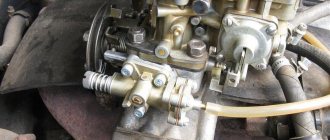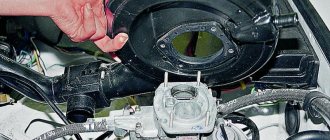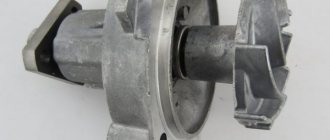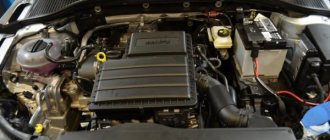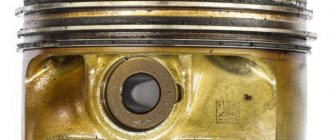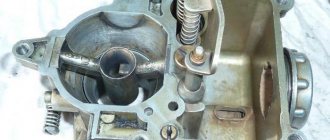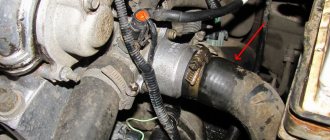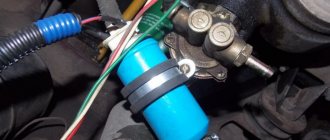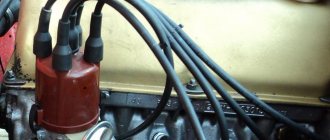Unstable idling of the engine with carburetor 2108 Solex and 2105, 2107 Ozone
Unstable idling of a car engine with a carburetor 2108, 21081, 21083 Solex or 2105, 2107 Ozone is one of the most common malfunctions.
In addition to the discomfort of operating a car with a shaking engine that is about to stall, a car owner faced with such a problem must be prepared for a rapid decrease in its service life, an increase in fuel appetite, loss of power, throttle response, etc. It should immediately be noted that these reasons typical for a warm car engine idling with the choke fully open and the throttle closed. Unstable engine operation in other modes may have other reasons and will be discussed in a separate article. — The engine is unstable at idle. It vibrates, “troits”, there may be popping noises in the muffler or carburetor. You can hear cylinder misfires and possible black smoke from the muffler. Shooting at the muffler indicates that the fuel mixture is too rich at idle, and shooting at the carburetor indicates that it is too lean. An over-rich or over-lean fuel mixture entering the engine cylinders at idle is at the root of all the causes of unstable idle speed. This is what we will start from when diagnosing and eliminating this malfunction.
— Idle speed spontaneously, then decreases, then increases (“floats”) . Typically, this phenomenon is observed when a separate piece of debris gets into the channels or jets of the CXX or the “suction” of foreign air into the carburetor. Periods of deterioration in idle performance may alternate with periods of stable operation. As a bonus, glow ignition can be added to unstable idle speeds - that is, the engine continues to run for some time after the ignition is turned off.
Causes of unstable idle
The engine idle speed control is broken
Most likely, for some reason the adjustment was made towards a leaner fuel mixture at idle. Adjust the idle speed using the “quantity” and “quality” screws of the fuel mixture, available on both the Solex and Ozone carburetors. For 2108, 21081, 21083 Solex normal idle speed is 750-800 rpm, for 2105, 2107 Ozone 850-900 rpm.
adjusting screws for the “quantity” and “quality” of the fuel mixture of carburetors 2108, 21081, 21083 Solex, 2105, 2107 Ozone
How to correctly and quickly adjust idle speed is described in the articles:
Carburetor solenoid valve faulty
The valve itself or the EPH system is faulty. If the valve fails completely, its needle will block the hole for supplying fuel to the idle system, and the engine will stall. At idle, it will only operate with the choke pulled out. If the solenoid valve shows signs of life, then idling is possible, but it will be unstable.
carburetor solenoid valves 2108, 21081, 21083 Solex, 2105, 2107 Ozone
Check the valve's condition. Turn on the ignition and remove the wire from it. You should hear a click when it fires. If there is no click, connect the valve terminal and the battery plus with a piece of insulated wire. There is no click, change the valve. There is a click, we check the EPH system. It turns off the fuel supply to the idle system when the idle speed increases above 1200 rpm and at forced idle; the carburetor solenoid valve is part of it. Articles on the topic: “Checking and repairing the EPH system of carburetor 2108, 21081, 21083 Solex”, “Checking and repairing the EPH system of carburetor 2105, 2107 Ozone”.
The channels and (or) jets of the carburetor idle system are clogged
The fuel mixture becomes lean. Unscrew the solenoid valve or the idle air system fuel nozzle holder installed in its place. Remove the idle air system fuel nozzle from it. Clean it, rinse with gasoline, blow with compressed air. If it is deformed or its markings are not correct, replace it. Check the integrity and presence of its rubber sealing ring.
solenoid valve of the 2108 Solex carburetor and the CXX fuel jet removed from it
It is possible to clean the CXX without removing the carburetor from the engine. Set the crankshaft speed within 3000 rpm. Unscrew the valve or holder a couple of turns. Apply the throttle by hand rotating the lever on the throttle axis of the first chamber. Screw the valve back on. Repeat the operation several times until stable idle speed appears. In this simple way we increase the vacuum in the CXX channels. It will carry all the deposits there into the cylinders. Before cleaning, you can pour a little acetone into the hole under the valve and wait until the deposits loosen.
Articles on cleaning the idle system on our website:
“Suction” of foreign air into the carburetor
In this case, the fuel mixture is depleted of excess air. The engine "troits". The image shows the location of possible “suction” of foreign air into the carburetor.
places of “suction” of foreign air into the carburetor 2108, 21081, 21083 Solex
How to look for places where foreign air is “sucked in” on engines with carburetors 2108, 21081, 21083 Solex and 2105, 2107 Ozone is described on our website in the article “Sucking foreign air into the carburetor.”
Low or, conversely, too high fuel level in the carburetor float chamber
The fuel mixture again becomes leaner or, on the contrary, becomes very rich, flooding the spark plugs. It is necessary to check and adjust the fuel level in the carburetor float chamber. First, remove the top part (cover) of the carburetor after the engine has been idling for a while. In the float chamber of the carburetor 2105, 2107 Ozone, the fuel level should be in the middle of the inclined plane of the front wall of the float chamber. On the 2108, 21081, 21083 Solex carburetor, the fuel level is approximately 29±1 mm from the bottom of the float chamber.
fuel level in the float chamber of carburetors 2108, 21081, 21083 Solex and 2105, 2107 Ozone
Read more about adjusting the fuel level in the carburetor float chamber in the articles:
In addition, you should pay attention to the integrity and position of the floats, and also check the needle valve, since the fuel level in the float chamber and subsequent mixture formation directly depend on them.
Articles about the valve:
Engine air filter element is very clogged
The degree of clogging should be quite high. For example, this one.
Idle speed fluctuates, causes, malfunctions
Understand that there are many reasons for the engine to be unstable at idle. In this case, much depends on the type of engine - carburetor, injection or diesel. Let's look at each of the options:
1. Let's start with domestic cars with a carburetor engine (for example, VAZ 2107 or VAZ 2109). So, why do the idle speeds fluctuate in our favorite “classics”.
There are several reasons:
The engine idle speed is incorrectly adjusted or it has gone astray during operation. At the same time, the setting shifted towards depletion of the fuel assembly (fuel-air mixture).
In this case, you just need to adjust the speed to 800-900 rpm; read the article on adjusting the carburetor yourself.
The carburetor solenoid valve has failed. In this case, the motor will only work when the choke is extended. If you remove the choke, the engine will immediately stall.
The idle air system jets or channels are dirty. If this happens, the fuel is starved of air as it enters the engine. The problem is often solved by simply cleaning the jet.
The sucking of “extra” air into the carburetor system inevitably leads to a lean mixture. As a result, the engine begins to stall and stall.
The following problems are also possible:
- Excessive (low) gasoline level in the float chamber.
- The air filter is clogged (here you can save yourself with a regular replacement).
2. In modern cars with an injection engine and electronic fuel injection, such as the VAZ 2110-2115, no less reasons can be identified. In this case, problems are often associated with the breakdown of one of the sensors.
What happens? The electronic control unit tries to read information and does not receive it. As a result, malfunctions in the operation of the power unit appear, and instability in speed appears.
But let's highlight all the main reasons. There are several of them:
- Problems with spark plugs (poor quality, wear, contamination);
- interruptions in the air supply (failure of the mass air flow sensor);
- air intake from outside into the intake system;
- damage (defect) of high-voltage wires;
- failure of the XX regulator;
- EGR sensor malfunction.
When the idle speed is floating, the first thing to do is check the idle speed control. Most often it is located next to another sensor that controls the throttle position. Checking is carried out using a multimeter.
If the sensor resistance is outside the normal range (40-80 Ohms), then there is a high probability of IAC failure.
If everything is normal with the idle speed control, you can move on to the next “suspect” - the mass air flow sensor.
To check the device, you need to disconnect the connector from it and start the engine. In this case, the engine speed will be around 1,500 rpm. If the dynamics only improve while driving, then the mass air flow sensor is really faulty.
VAZ 2107 carburetor idle speed floats
There may be several reasons for this unpleasant problem:
The IAC idle speed controller is malfunctioning
The idle speed of the engine changes by itself and it may even stop; often the engine does not want to start without pressing the gas pedal. And the “Check Engine” lamp may not light up. At medium and high speeds, the engine keeps its speed evenly, and no loss of power is noticeable.
Problems with the mass air flow sensor (mass air flow sensor)
If the mass air flow sensor is faulty, the speed may change not only at idle speed, but also at any other throttle opening, even when driving under load. A car can put its owner in a very dangerous situation by suddenly losing traction while overtaking. The check engine light is usually on. If you notice these signs, you will need to replace the faulty sensor. Read how to do this here
Air leaks through cracks in hoses and seals
Excess air that enters the engine intake tract bypassing the mass air flow sensor depletes the combustible mixture. The speed and power of the motor changes, the controller tries to correct this. As a result, the speed and “traction” change. But unlike the case with a faulty mass air flow sensor, this does not happen so abruptly. The Check Engine light does not come on.
Carefully inspect all tubes and hoses that extend from the throttle body, gaskets, the throttle body itself, and the intake manifold for cracks. Pay special attention to the hose going to the vacuum brake booster, as it often cracks. It also happens that the vacuum booster itself begins to “poison” the air and then when you press the brake pedal, the engine speed will change. Eliminate all these faults and the engine will start running smoothly again.
Other reasons
A car is a very complex system and it is simply impossible to describe the incredible variety of possible combinations of breakdowns. The engine may “jerk” when driving and change speed due to a malfunction of the ignition system, injectors, bad gasoline, water getting into the tank, dirty filters, etc. In each specific case, you need to carefully analyze all the signs and draw conclusions. If all else fails, you can always undergo verification diagnostics with a motor tester.
What is idle air control
When we release the gas pedal, the throttle valve closes completely, blocking the path of air into the intake manifold. In this case, engine operation is ensured by a small cross-section bypass channel, through which air flows for idle operation. A device is installed in the channel that has the ability to change its flow area and even completely block it. This mechanism is the idle speed regulator. With its help, the ECU controller can maintain and change engine speed at idle. For what? For example, when we start a cold engine and it runs unsteadily, when we turn on the heating or air conditioning, thereby adding to the load. Having received information from the crankshaft speed sensors, throttle position, speed sensor, and temperature, the controller processes it and sends a command to the idle speed controller - “add air” or “reduce air.” As a result, we have stable and smooth engine operation when the gas pedal is released.
How he does it? A stepper motor is hidden inside the housing. Short pulses are applied alternately to its two stator windings and the rotor shaft rotates to a certain angle. A screw connected to the rotor acts on the throttling element (needle), pushing it out or pushing it into the hole. The flow area of the channel changes, and the idle speed changes accordingly.
Idle air control - device, connection, general view
The regulator may stop working for various reasons. Most often, the mechanical part fails - the needle drive parts break or jam. Idle air regulators bought in stores “on the cheap” are especially prone to this because of their low quality. Failures of the electrical part occur less frequently - burnout of windings, wire breaks, wear or corrosion of the contact block.
Before replacing the regulator, we need to make sure that the reason is in it, and not in the power supply wires and connectors. To do this, turn on the multimeter in the mode up to 20 volts, check the voltage at contacts “B” “D” with the ignition on. It should be about +12 volts. If the voltage = 0 or is much lower, then the cause of the malfunction is somewhere else. It is necessary to check all circuits from the controller to the regulator and the controller itself.
Which one should I buy as a replacement?
A regulator from VAZ injection models is suitable, for example this one 2112-1148300-02 from the twelfth model. When choosing, pay attention to the build quality and packaging. It is better to buy products from large, well-known manufacturers. And it doesn’t hurt to ask the seller which ones they take more often.
Regulator replacement procedure
Disconnect the negative and positive terminals from the battery.
Disconnect the battery terminals
Disconnect the throttle cable. Loosen the clamps and unhook the hoses and pipe from the air filter.
Loosen the pipe clamp and remove it
Unscrew the throttle body mounting nuts and slide it off the studs. Remove the washers and finally remove the housing. Disconnect the throttle position sensor and idle air control connectors. Unscrew the screws securing the idle air regulator and remove it. Install the O-ring on the new regulator and reassemble everything in reverse order.
Don't forget to install a new O-ring
Some craftsmen replace the regulator without removing the throttle body, some remove the body and turn it without disconnecting the hoses. You can act in the way that is most convenient for you, the main thing is not to confuse anything.
Post-installation setup
After replacing the regulator, you need to give the computer a chance to configure it. To do this, you need to turn on the ignition and wait for about ten seconds without starting the engine. Then turn off the ignition and wait at least three seconds. Turn the ignition back on and start the engine. Drive a few meters forward or backward. The adjustment is complete, the computer has received all the necessary data and calibrated the idle air control.
Why does the idle speed jump on a VAZ 2107?
What to do if the idle speed of a VAZ 2107 jumps, is there any panacea for this? The fuel system causes a lot of trouble for owners, but one thing needs to be taken into account - it is not always to blame. For example, in carburetor engines with a classic ignition system, there is a high probability of contact group failure if there is instability in the idle speed. But with injection engines everything is somewhat simpler. And now about everything in more detail.
Video - Easy setup of XX with your own hands
This is how the idle speed on the VAZ 2107 carburetor is adjusted. As you can see, it is not at all difficult.
Are you familiar with the situation, dear friends, when the car engine is idling unstable? Many will say, “Something with the carburetor.” I agree, but what exactly? I won’t bother you, in most cases it is necessary to adjust the idle speed. Of course, if a modern car is available, then its owner usually doesn’t look beyond the interior; a different matter is the good old “classic”. Each of its owners tries to master the entire structure of the unit as much as possible, because when cutting through the expanses of Mother Russia, anything can happen and you need to be prepared both theoretically and practically.
Setting up a carburetor is not an easy task and it is best to entrust it to professionals, but it’s not for me to tell you about the Russian mentality. We don’t want to pay some guy when we can do everything ourselves, they’ll suffer, but we’ll do it! Self-adjusting the idle speed of the VAZ 2107 will save time and money that you spend at a car service center. Moreover, this skill will be especially useful in unusual situations far from home. With this publication I will prove to all pessimists that anyone can adjust the idle speed directly with their own hands.
Why is the engine speed unstable?
When it comes to the carburetor, there are several reasons:
- The carburetor is clogged, the movement of air and gasoline becomes impossible.
- The operation of the solenoid valve is disrupted - the winding is burned out or the nozzle is clogged.
- Fuel or air filters are clogged.
- Incorrect carburetor adjustments on VAZ 2107.
In most cases, the culprit is the solenoid valve. Its appearance is shown in the photo. It is necessary in the power system for the following purpose - it opens the fuel supply when the ignition is turned on and closes it when it is turned off. Consequently, the engine stops immediately after turning off the ignition.
The VAZ 2107 carburetor solenoid valve is a small device consisting of the following elements:
- Frame.
- Winding (one end connected to a metal body).
- A rod that acts as a valve that opens and closes the fuel supply at idle.
- Copper jet with holes. Please note that the jets are marked; there are several sizes.
The solenoid valve operates only when the ignition is on. If suddenly there is a break in the power circuit, you can temporarily connect the central wire of the device to the positive terminal of the battery. Just try to carry out repairs as soon as possible.
Idle speed fluctuates, causes, malfunctions
Understand that there are many reasons for the engine to be unstable at idle. In this case, much depends on the type of engine - carburetor, injection or diesel. Let's look at each of the options:
- Let's start with domestic cars with a carburetor engine (for example, VAZ 2107 or VAZ 2109). So, why do the idle speeds fluctuate in our favorite “classics”.
There are several reasons:
The engine idle speed is incorrectly adjusted or it has gone astray during operation. At the same time, the setting shifted towards depletion of the fuel assembly (fuel-air mixture).
In this case, you just need to adjust the speed to 800-900 rpm; read the article on adjusting the carburetor yourself.
The carburetor solenoid valve has failed. In this case, the motor will only work when the choke is extended. If you remove the choke, the engine will immediately stall.
The idle air system jets or channels are dirty. If this happens, the fuel is starved of air as it enters the engine. The problem is often solved by simply cleaning the jet.
The sucking of “extra” air into the carburetor system inevitably leads to a lean mixture. As a result, the engine begins to stall and stall.
Preparing to adjust the idle speed
If you do not plan to clean and disassemble the VAZ 2107 carburetor, then one of the tools you will need is a screwdriver. A device for measuring the speed (tachometer) is installed in the dashboard. But it’s worth getting a mixture quality indicator. With its help you can create an air-fuel mixture in ideal proportions. This article will talk about adjustment using this device.
Before starting work, you need to warm up the engine to operating temperature. Let us remember that this is a temperature of about 90 degrees. You also need to put the air purification filter in place to simulate normal engine operation. Make sure the float is adjusted correctly. The fuel level in the chamber must always be stable.
There are also many requirements for ignition and gas distribution. Be sure that all clearances must be correct, and the ignition timing must be adjusted for the gasoline used. And most importantly, open the air damper completely while making the adjustment. That's all, the preparation work is briefly summarized, now you can begin the idle adjustment procedure.
Setting up the power unit
Adjustment of the idle speed is carried out indoors with good ventilation or outdoors. It is necessary to make sure that the air damper is completely open, for which the handle is pushed forward until it stops. Now the carburetor is completely ready for setting the mode.
The wizard's sequence of actions is as follows:
- A device sensor is inserted into the exhaust pipe, which determines the concentration of carbon monoxide in the exhaust. The device turns on, and readings are taken from it that characterize the operation of the carburetor.
- If the established parameters are exceeded, the mixture quality screw is tightened using a screwdriver. This action is performed in several stages with constant monitoring of the exhaust.
- The drop in idle speed is compensated by the fact that the VAZ 2107 carburetor is adjusted by the mixture amount screw.
The procedure continues until the engine operates stably in this mode. If the device is not available, adjustment of a working carburetor on a VAZ 2107 car can be done without it. With a certain skill, this operation will not take much time.
Setting the idle speed of the VAZ 2107
Carefully inspect the carburetor, there are several screws on it - the quality of the air-fuel mixture and quantity. It is with their help that we will now try to adjust the carburetor. Of course, not every driver has such a device as a gas analyzer. However, not everyone cares about the level of CO in the exhaust. For convenience, it is advisable to have a digital or dial tachometer. You can find how to connect it correctly in the corresponding article on our website.
So, start the engine and turn the quality screw. Listen to the engine, you need to stop at the moment when the crankshaft speed is at its maximum. After this, you begin to rotate the quantity screw and achieve a frequency of 1100. And the last step is to set the frequency to 800-900 using the quality screw. Please note that if necessary, the idle speed adjustment must be repeated.
Instead of a candle, screw in a mixture quality indicator and achieve the optimal color - violet-blue or blue. Adjusting the quality of the mixture using this device is simplified. True, you will need to turn the quality and quantity screw a few more times.
Adjustment without additional devices
If you couldn’t find special devices, you can make adjustments without a gas analyzer, but only if you have a tachometer. The procedure is basically the same, only you need to turn the screws a little differently.
- We set the mixture quantity screw to the position of the nominal crankshaft speed (820/900 rpm).
- Using the quality screw we catch the maximum speed.
- We increase the crankshaft speed to 950-1035 rpm (15%), using the quantity screw.
- We check the quality screw; it should be in the position of the maximum possible revolutions for the current location of the quantity screw.
- We repeat steps 3 and 4 until, after completing the third step, adjusting the quality screw will only lead to a decrease in speed.
- We tighten the quality screw to the nominal speed.
What about the injector?
Everything is a little simpler here, since no adjustments are needed. The reason is that a smart on-board control system is responsible for everything. And specifically for idling - the regulator (IAC). Some may call it an idle speed sensor, but this concept is completely wrong. The fact is that there are two types of devices on injection cars - sensors (reading) and actuators. The idle air control is a stepper motor; it does not measure anything, but on the contrary, it opens and closes the air supply through a special channel.
A breakdown of the IAC can only be determined by external signs, and then only relatively. The fact is that the control lamp on the dashboard will not light up if the regulator suddenly fails. But if you feel unstable revolutions, or they have disappeared completely, and the engine jerks and stalls, then first of all, of course, it is worth checking the performance of the IAC. It is worth noting that sometimes the “Check” can light up when the IAC is faulty. This happens if the engine detonates. The knock sensor signals a malfunction to the electronic control unit.
IAC breakdowns
If you have a VAZ 2107 with an injection engine, then pay due attention to the condition of the vehicle systems. If the speed on an injection engine fluctuates, then you need to look first at the idle speed control. The fact is that the breakdown of such a mechanism as the IAC can lead to very sad consequences, including a traffic accident. Here are the main signs by which you can independently determine whether the regulator is broken:
- The engine begins to “live its own life” - the crankshaft rotation speed is constantly changing, sometimes decreasing, sometimes increasing. Consequently, the tachometer needle constantly floats.
- When you start a cold engine, the crankshaft speed does not increase, it fluctuates within a certain range.
- If you turn on powerful electrical appliances (for example, a car radio, low or high beam), the speed decreases and does not return to the set level.
- When you engage the neutral gear, the engine begins to stall if you do not apply the gas pedal from time to time.
These are the main signs that the regulator is faulty. In fact, any interruptions in the idle level are the first sign of a breakdown or minor defect in the IAC. But the time has come to diagnose it. It won't be difficult to do this.
Adjusting the throttle drive
This drive must be configured correctly, otherwise the car will have worse speed dynamics. In order to set it up, you will need a partner, an 8 wrench, a simple screwdriver, a caliper and a flashlight.
How to adjust correctly:
- First of all, press the “suction” all the way.
- The partner must press the gas to the floor. In this case, if adjusted correctly, the throttle valve will rise vertically. Shine a flashlight to make sure.
- Let your partner release the gas pedal, at the same time the flap closes the primary chamber without gaps.
- If the damper has not fully opened or closed, it will be necessary to adjust the length of the drive rod.
- Remove the rod and measure its length. It should be exactly 80 mm. If there is a discrepancy, tighten the locknuts to achieve the desired length.
Throttle valve drive diagram
It is worth noting that there are still a number of operations with the carburetor, but by performing the steps described above, you will get rid of most problems with the air-fuel mixture. If you have more serious problems, it would be better to contact a specialist on this issue. As a rule, following the proposed instructions is enough for high-quality carburetor adjustment.
Carrying out diagnostics
The simplest method is to measure the voltage at the block to which the regulator is connected. These are terminals D and A. When the ignition is turned on, a voltage of 12 V should be present on them. If the voltage is less than this value, it is worth looking at the battery and generator. It is quite possible that the battery is undercharged. In the same case, if there is no voltage at all, it is necessary to check the entire power circuit of the device and diagnose the ECU.
Set the multimeter to resistance measurement mode. Between pairs of terminals A and B, C and D, there should be a resistance of approximately 53 ohms. Remove the IAC and connect (with the ignition off) to the block. Then turn on the ignition and look at the behavior of the needle - it should extend completely when voltage is applied. If this does not happen, we can judge that the IAC is broken.
Sometimes simply cleaning the regulator helps. To do this, you can use sprays, of which there are sufficient quantities in stores. But in some cases, only replacing the device will help. Of course, this is not a DAAZ carburetor, the cost of the IAC will be many times lower, and there will be no problems with replacement. If, even after the replacement, the engine does not idle, it is necessary to fully diagnose the injector.
Carburetor speed fluctuates
You rarely see imported components on domestic cars. Basically, AvtoVAZ engines are equipped with a Solex or Ozone carburetor. Less often you can find products from the Dimitrovgrad Aggregate Plant, known for its reliability: the DAAZ carburetor. Drivers of relatively modern cars, accustomed to the check engine light, can easily determine any malfunction using an on-board computer or an inexpensive car scanner, but for veteran engine owners, only hardware diagnostics are available.
A common malfunction is idle speed floating, the main symptoms are:
- It would seem that the problem does not affect the speed - with intensive use of the gas pedal, the malfunction is invisible. However, it is dangerous in traffic jams, when the engine may suddenly stall, and when engine braking on a long descent;
- In addition, increased vibrations do not add life to the motor and attachments. Bearings of rotating shafts experience axial loads that are not typical for them. And it is uncomfortable for passengers to be in the car when the tachometer needle jumps from 500 to 1500 rpm.
The driver is forced to constantly apply gas, this distracts from the road and increases gas consumption.
So, manifestations of floating idle:
- The tachometer needle moves smoothly or sharply in the range of 1000 revolutions;
- The car shakes noticeably: there is always a feeling that it will stall;
- Pops of unburned fuel in the muffler and under the hood. In the first case, the mixture is rich, in the second, it is lean;
- Vibrations similar to tripping (at the same time you are sure that the spark plugs and the high-voltage part of the ignition system are in good condition);
- The motor randomly picks up speed, then smoothly reduces it. The problem is non-linear, it suddenly appears and also disappears suddenly (this somewhat complicates the diagnosis).
It is not difficult to localize the fault. If (we repeat: in the absence of other malfunctions), the speed fluctuates, look at the carburetor.
Idle speed fluctuates: main reasons
Welcome, friends, to the DIY car repair website. One of the very common problems found on almost all cars is floating idle speed.
Such a minor (at first glance) malfunction is very annoying and can cause a lot of inconvenience on the road. For example, at an intersection, a car can stall at any time when the speed decreases.
The driver, in turn, has to constantly apply pressure to the gas to keep the engine in good shape.
Why the speed fluctuates - localization of the fault
First, you need to cut off potential sources of the problem close to the carburetor.
- Let's leave the fuel supply alone. It (gasoline) is either there and the engine is running, or it is not there and there is no problem with idling (as well as the engine itself);
- A potential culprit is a clogged engine air filter. The main cause of uneven idle is air, or rather oxygen, so we inspect the first obstacle in the way of oxygen especially carefully. If you changed the filter at the end of spring, it may be clogged with June poplar fluff. Regular trips on primers, or clouds of dust donated by the “coaters”, coke the pores of the filter element within a month. It happens that a low-quality product from “homemade” ones from the Middle Kingdom simply breaks into shreds and clogs the carburetor throttle assembly with scraps. In any case, let's start by checking the filter;
- The diametrically opposite reason is excess oxygen. The intake tract of an internal combustion engine is relatively sealed. All incoming air flows are carefully calculated by engineers. In injection systems there is a mass air flow sensor, and the ECU can adjust the mixture parameters depending on the oxygen flow. The carburetor has only a mechanical setting for a certain volume. Any unauthorized air leak causes floating speed. The filter breaks, the valve cover gasket breaks, or the carburetor seal leaks - and unaccounted for (and also dirty) air goes into the chamber. The leak can be on the fittings of the vacuum tubes and on the crankcase ventilation system.
A less common cause is the housing or diaphragm of the distributor vacuum regulator. That is, the device responsible for the stable operation of the power unit is itself the cause of the malfunction.
If none of the listed reasons are found, we will inspect the carburetor. Moreover, no special equipment, much less electronic devices, is required.
Float Setting
To begin the setup, the first step is to remove the air filter. Then unscrew the lid of the device and look at the fuel level. The maximum fuel level will be in the chamber where there is a needle valve. Next, check the float. It should only lightly touch the valve. To adjust the float you will need a special template. It can be made from paper. Its dimensions should be 6.5×14 mm. This template is installed below the float. The normal size for this carburetor from the gasket to the float should be about 6.5 mm.
If this size does not correspond to the normal one, adjust the float tongue. By moving the float away from the lid or to the other side, you can adjust the opening of the needle valve. The template installed at the bottom of the float must match the size. By manipulating the stop on the bracket to which the float is attached, the required size is set, if it differs from the factory one.
Methodology for finding problems on domestic carburetor systems
Before you start troubleshooting, you need to check that the carburetor is adjusted correctly. The manufacturer sets the settings for ideal operating conditions - the amount of oxygen in the atmosphere of flat terrain and gasoline that complies with GOST. And this is on a new car.
In reality, periodic adjustment of all 4-5 carburetor adjustment screws is required. At least two of them are responsible for stable idle operation. The adjustment is made with the engine running using a simple screwdriver.
The procedure is described in the owner's manual, and differs slightly depending on the carburetor model. The main condition for correct tuning is the absence of leaks, a clean air filter, and high-quality gasoline. The amount of oxygen in the air corresponds to daily use. That is, if you live on a plain, there is no point in adjusting the carburetor while climbing a mountain serpentine to an altitude of 800 meters above sea level.
- Warm up the engine to a temperature of 90°C. If there is no thermometer, the degree of heating can be easily determined by the opening of the cooling system thermostat;
- We start the engine, give a small load - turn on the headlights and the climate system (without air conditioning). Each type of carburetor has its own idle speed, let’s take 750-800 rpm as a basis, as on Solex. The idle speed is controlled by the “quantity” and “quality” screws of the mixture. It will not be possible to establish normal speed with wine alone;
- The forced choke lever (choke) is closed;
- Using the “quality” screw, we adjust the speed to the maximum possible value. As a rule, the screw is fixed at the factory and closed with a plug. It needs to be removed;
- Next, using a standard (on the dashboard) or remote tachometer, set the speed to 900, turning only the “quantity” screw;
- Then use the “quality” screw to set the required value: 750-800 rpm.
Afterwards, you need to start the engine in normal mode, make a test drive, and accelerate in neutral several times to the maximum speed. Then turn off the engine, and after a couple of minutes start it again and check the number of revolutions at idle with a load (high beam + heater). If necessary, repeat the adjustment process.
Carburetor operation
It involves precise dosing of fuel and air. This means that carburetor adjustment is also necessary. VAZ 2105 and later models control this process with special plugs - “jets”. Their “performance” is known to be determined by both the length and diameter of the throughput hole, as well as the difference between the inlet and outlet pressures. There is a nonlinear relationship between the cross-sectional area and the throughput of the jets. It is this that is the basis when adjusting the carburetor of the VAZ 2110 and earlier models. This means that by increasing the cross-section by, say, ten percent, you can get a twenty-five percent increase in throughput. Knowing this little trick, many car enthusiasts try to increase power and at the same time reduce the car’s fuel consumption.
The carburetor is adjusted, there are no other faults, but your engine speed still fluctuates
Next comes the search for real carburetor faults.
- Checking the idle speed solenoid valve. If you briefly apply power to it (by resetting and replacing the connector), you should hear a characteristic click. A faulty valve must be replaced;
- The float chamber needle valve is stuck. You will have to disassemble and wash the carburetor. If this does not help, the valve is replaced with a new one; it is impossible to sharpen or restore it at home;
- The idle passages or jets are clogged with debris. Flushing is required, preferably with the carburetor removed. A special detergent (such as “carbcleaner”) is used, then the channels are blown out with compressed air. A compressor will not work; it is better to use an inflated spare tire and a blow gun.
By and large, there are no other reasons for a floating idle associated with the carburetor. If after carrying out the above procedures, the problem remains, then this is a banal problem, with its own symptoms and causes.
The mechanical system for forming the fuel mixture requires literally surgical cleanliness of the internal components. Neglect of timely replacement of filters, as well as saving on matches (the cheapest gasoline in the area), lead to regular problems with the engine. However, eliminating them is not difficult - all you need is a simple tool and a steady hand.
